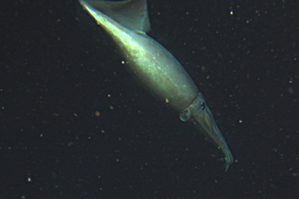 Humboldt Squid. Photo: NOAA/CBNMS.
Humboldt Squid. Photo: NOAA/CBNMS.
Large numbers of Humboldt squid, deep purple-red and up to six feet long, have propelled themselves into Monterey Bay mid-summer since 2002. They spend the fall and early winter here, probably to feed, and then spend spring further south. But this year, the squid have yet to arrive. No one knows if the squid are behind schedule or if they’re not going to show up at all. Humboldt squid isn’t the most popular item on the menu in North America, but it is very big in Japan, making it the world’s 14th largest fishery by weight. And, their absence leaves a hole in Monterey Bay’s food chain. The Humboldt squid are voracious predators, feeding on anchovies, sardines, rockfish, market squid, and crustaceans. The delayed arrival of the Humboldt squid is a mystery, and it could have consequences for the underwater ecosystem—in Monterey Bay and all along the coast of California.
Humboldt squid haven’t been in our waters forever. Check out QUEST’s TV story The Fierce Humboldt Squid for the full story. Historically, the Humboldt Squid have lived in equatorial waters of the Pacific, from Chile to Mexico. In the 1930s, their range extended further north, and they were caught by fishermen in Monterey. Then they disappeared, only to return briefly in 1997. But they returned again in 2002, and have every year since.
There are a few hypotheses about why the squid come and go. Maybe they are responding to changes in their food supply. Or, their populations may grow when there are fewer predators—Humboldt squid are eaten by tunas, sharks, and sperm whales, some of which are in decline. Another possibility is the warming of northern waters, caused by El Niño. Trade winds usually blow from east to west across the Pacific, piling up warm water near Indonesia. During an El Niño, the trade winds die down, and warm water moves eastward, towards North and South America. The typically cold waters of Monterey Bay become unusually warm—warm enough, scientists think, for the Humboldt Squid to move in. The squids returned in 1997 and again in 2002—both were El Niño years. After 2002, the warm El Niño waters didn’t stick around, but the Humboldt squid kept coming back. This year, the squid are absent, and this is surprising because it seems to be an El Niño year (remember all that rain we got this past winter?).
